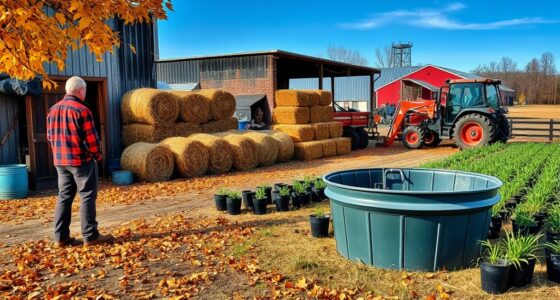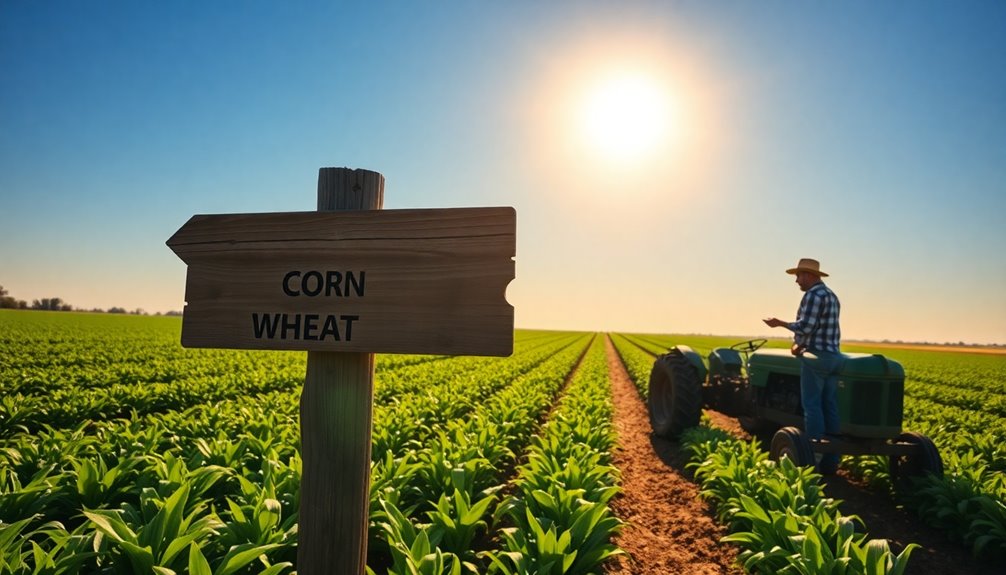Off-grid farming depends on innovative power solutions that leverage renewable energy sources. By installing solar, wind, micro-hydro, or biogas systems, you can greatly reduce energy costs and enjoy energy independence. Solar power can cut your energy bills by up to 80%, while wind and micro-hydro provide reliable alternatives. Don't forget to integrate energy storage for consistent power supply. There's a lot more to explore about these sustainable options and how they can transform your farming experience.
Key Takeaways
- Off-grid energy solutions utilize renewable resources like solar, wind, and biogas to promote energy independence for remote farming.
- Solar power systems, including panels and batteries, can reduce energy costs by up to 80% in off-grid settings.
- Wind energy systems can significantly lower operational costs, especially in areas with consistent wind speeds of 12 to 25 mph.
- Micro-hydro systems provide a reliable power source with minimal maintenance, ideal for farms near flowing water.
- Government incentives can cover up to 25% of installation costs, making renewable energy solutions more affordable for farmers.
Understanding Off-Grid Energy Solutions
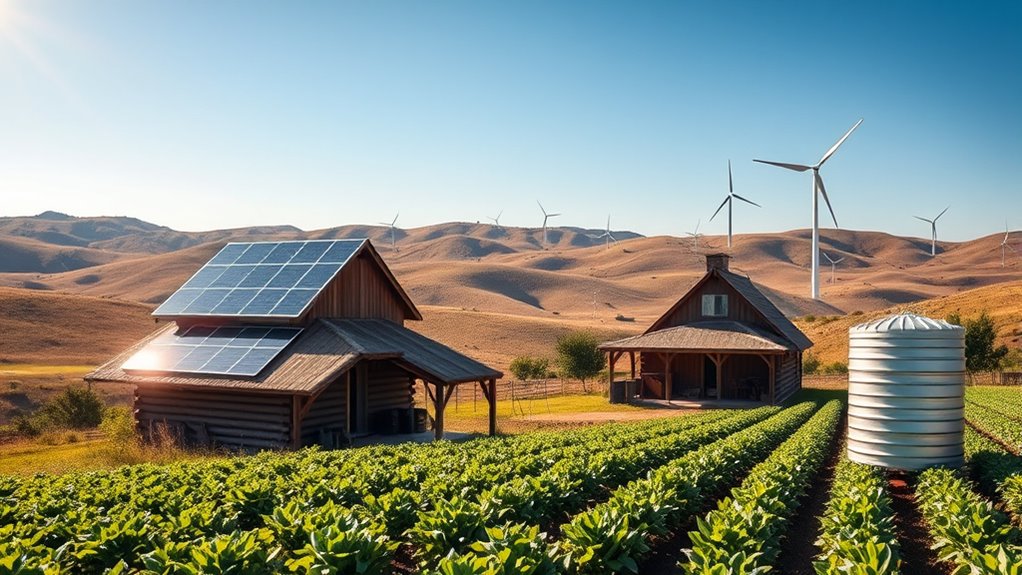
When you embrace off-grid energy solutions, you're not just powering your farm; you're investing in a sustainable future. Off-grid power harnesses renewable resources like solar, wind, and biomass, giving you energy independence and reducing reliance on fossil fuels.
A solar power system is often at the heart of these solutions, featuring solar panels, inverters, and energy storage batteries that can cut your energy bills by up to 80%. By tailoring these systems to your farm's specific needs, you guarantee maximum efficiency.
Plus, integrating wind turbines or biogas systems can further enhance your energy strategy, utilizing local resources while minimizing your carbon footprint. With off-grid energy, you're not just saving money; you're cultivating a greener world. Additionally, incorporating solar charge controllers can optimize the performance of your solar power system, ensuring efficient energy management.
Solar Power Systems for Off-Grid Farming
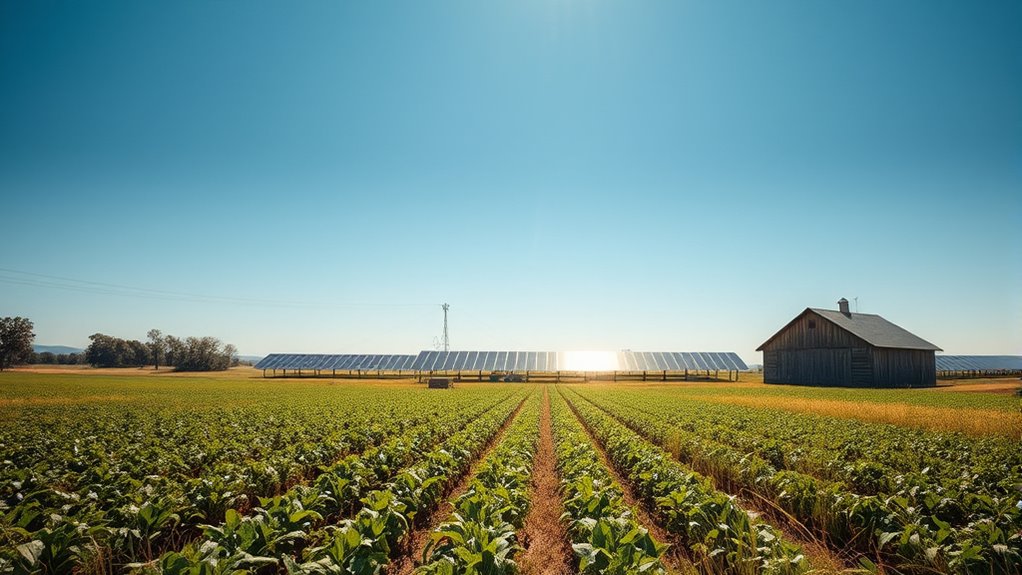
When you consider solar power systems for your off-grid farm, it's essential to understand the key components, like solar panels and batteries, that make your setup functional.
You'll also want to learn about installation and maintenance tips to keep everything running smoothly. By mastering these aspects, you can maximize your energy independence and savings.
Key Component Overview
As you explore solar power systems for off-grid farming, you'll find that they consist of several key components: solar panels, a charge controller, batteries for energy storage, and an inverter.
These elements work together to provide a reliable and sustainable energy source for your farming needs.
- Solar panels capture sunlight and convert it into electricity.
- Charge controllers regulate the flow of energy to prevent battery overcharging.
- Energy storage batteries, particularly lithium iron phosphate, guarantee you have power when the sun isn't shining.
- Inverters convert the stored DC electricity into AC for your appliances.
Installation and Maintenance Tips
Installing a solar power system for your off-grid farm requires careful planning to guarantee peak performance. Start by evaluating your site for ideal sunlight exposure, positioning your panels to capture maximum sun throughout the day.
While initial installation costs range from $15,000 to $30,000, government incentives can greatly lower this investment.
For maintenance, regularly clean your panels to remove dirt and debris, and check connections and the inverter to verify everything runs smoothly.
Invest in high-quality energy storage, like lithium iron phosphate batteries, which can last over 10 years or 10,000 cycles.
Finally, utilize a mix of AC and DC wiring to accommodate various appliances, and opt for energy-efficient devices to enhance your system's overall efficiency.
Harnessing Wind Energy for Sustainable Agriculture
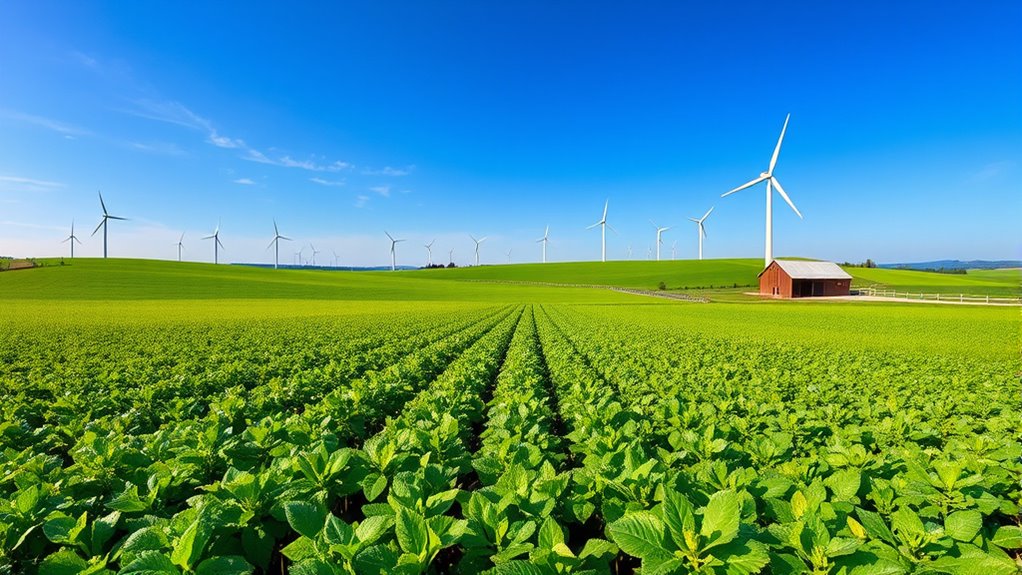
Harnessing wind energy can transform your off-grid farm into a sustainable powerhouse.
By understanding wind turbine efficiency factors, you can maximize the benefits of wind power, greatly cutting energy costs.
Let's explore how this renewable resource can support your agricultural needs and enhance your energy independence.
Wind Turbine Efficiency Factors
When you're considering wind energy for sustainable agriculture, understanding the factors that influence wind turbine efficiency is essential.
Maximizing energy production in your off-grid energy setup requires careful attention to these key elements:
- Average Wind Speed: Turbines perform best at speeds between 12 to 25 mph, so site selection is important.
- Tower Height: Taller towers capture stronger winds, enhancing efficiency and output.
- Turbine Design: Horizontal-axis wind turbines (HAWTs) are generally more efficient than vertical-axis options (VAWTs).
- Turbine Placement: Position turbines away from obstructions like trees and buildings to minimize turbulence and optimize airflow.
In addition to these factors, wind energy is indirectly generated by solar energy through temperature differences, which can further enhance the efficiency of your wind turbines.
Benefits of Wind Power
Wind power offers numerous advantages that can transform the landscape of sustainable agriculture. By harnessing this renewable energy, you can provide a reliable electricity source for your remote farm, especially in areas with consistent wind.
Investing in a small wind turbine, which costs between $3,000 and $8,000 per kilowatt, can lead to significant savings on energy bills over time. Plus, it boosts your energy independence, allowing you to utilize local resources during peak demand seasons when energy prices spike.
Wind energy also helps reduce greenhouse gas emissions, supporting environmental sustainability. With a potential return on investment within 6 to 10 years, adopting wind power can be a financially viable option for your off-grid farming needs.
Exploring Micro-Hydro Electricity Systems
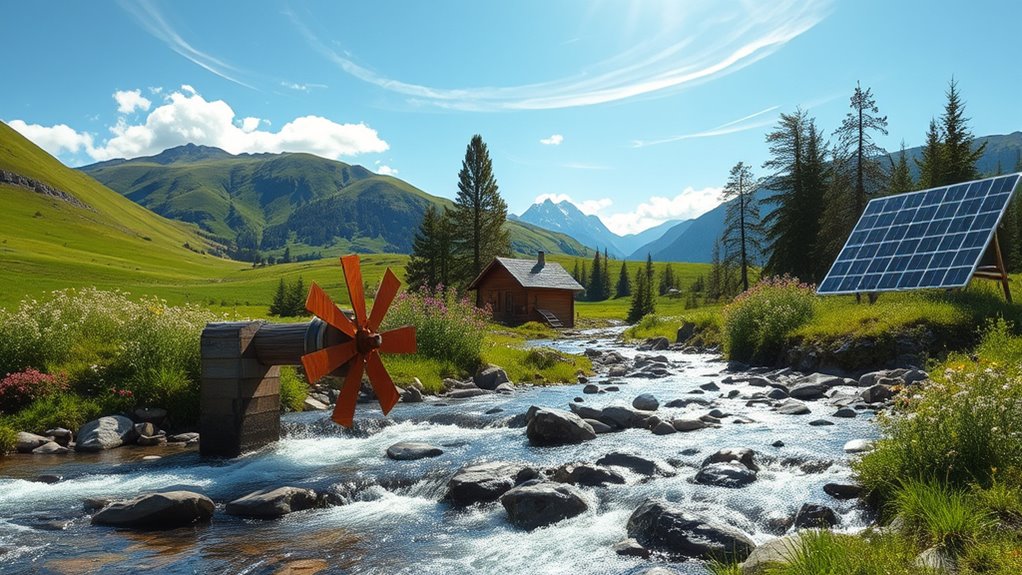
Micro-hydro electricity systems offer a reliable and efficient way to generate power, especially for those living off the grid. If you have access to a stream or river, these systems can provide a consistent energy solution tailored for your remote area.
By harnessing the flow of water through a turbine, micro-hydro setups convert kinetic energy into electricity, often producing between 100 watts and several kilowatts.
Harnessing water flow through turbines, micro-hydro systems efficiently convert kinetic energy into electricity, generating up to several kilowatts.
- Minimal maintenance compared to solar or wind systems
- Continuous power supply, even in low sunlight or calm winds
- Cost-effective with payback periods of 3 to 7 years
- Ideal for properties with a reliable water source
Investing in micro-hydro can greatly enhance your off-grid farming experience.
The Benefits of Biogas Energy Systems
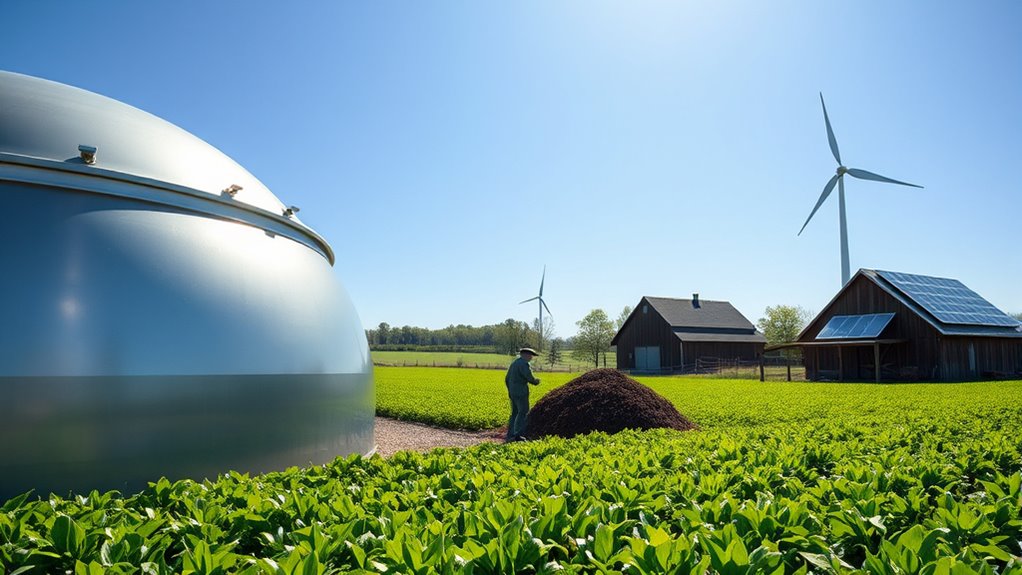
As you explore sustainable energy options for your off-grid farm, biogas energy systems stand out for their ability to transform organic waste into a valuable resource.
By converting livestock manure and food scraps through anaerobic digestion, these systems generate biogas, a reliable source of renewable energy. This biogas can fuel generators for electricity, heat water, and power cooking appliances, greatly reducing your reliance on fossil fuels.
Additionally, the nutrient-rich digestate produced enhances soil health, promoting sustainable farming practices. Implementing a biogas system can lead to substantial cost savings, as you'll lower waste disposal expenses and generate free energy.
With efficiency rates of 50-75%, biogas energy systems offer a practical solution for managing waste while powering your off-grid farm.
Geothermal Heat Pump Energy Solutions
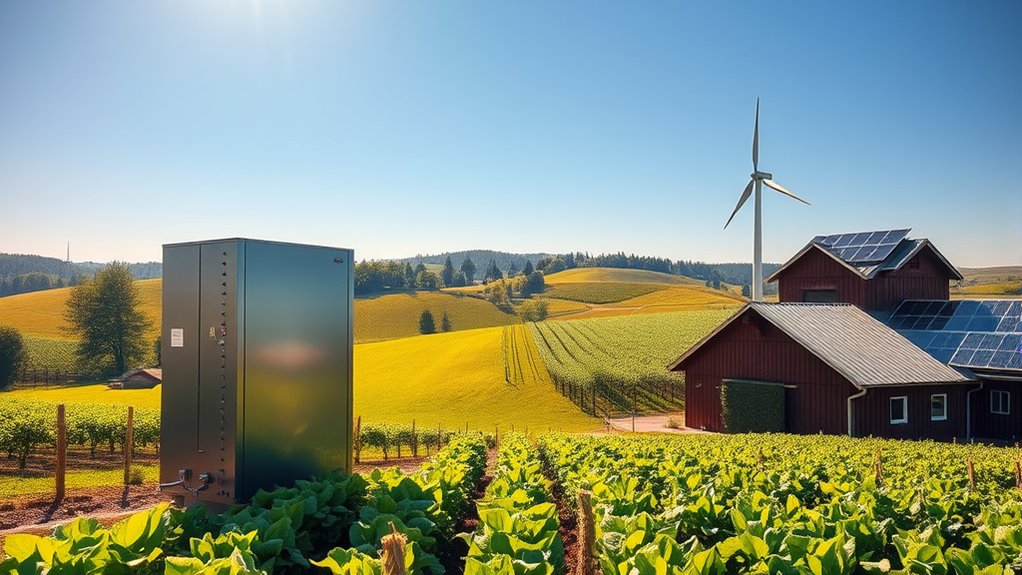
When considering energy-efficient solutions for your off-grid farm, geothermal heat pump systems offer a sustainable way to heat and cool your buildings.
These systems utilize the earth's consistent temperature to maximize efficiency, achieving 300% to 600% energy efficiencies. They consist of a ground loop, a heat pump unit, and an air distribution system that work together seamlessly.
Here are some benefits of geothermal heat pump energy systems:
- Reduces reliance on fossil fuels
- Provides consistent heating and cooling
- Offers long-term savings on energy bills
- Typically has payback periods of 5 to 10 years
Integrating Energy Storage for Reliability

Integrating energy storage systems into your off-grid farm can greatly enhance your power reliability, especially during times of low energy generation.
By utilizing battery storage, like lithium iron phosphate batteries, you can guarantee a dependable energy supply that lasts up to 10 years, considerably outperforming traditional lead-acid options.
Properly sizing your energy storage is essential; it should match your farm's energy consumption patterns and account for peak usage times.
Proper energy storage sizing is crucial for aligning with your farm's consumption and peak usage demands.
Additionally, consider time-of-use energy pricing to charge your batteries during off-peak hours, optimizing costs.
Combining energy storage with solar energy or wind generation allows for a stable power supply, reducing reliance on backup generators and minimizing your greenhouse gas emissions, making your farm more sustainable.
Assessing Your Energy Needs for Off-Grid Living
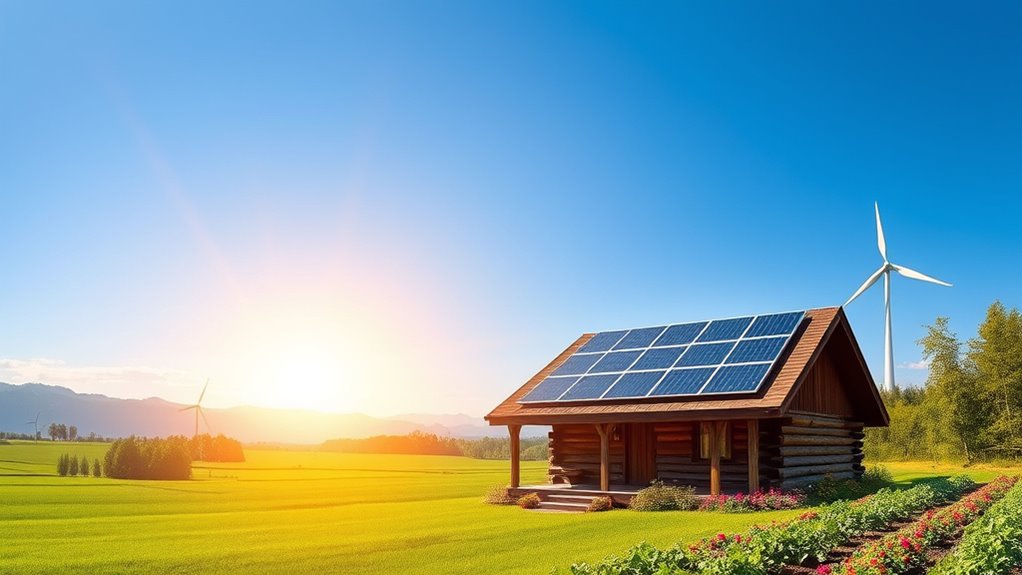
To successfully live off-grid, you need to start by accurately evaluating your energy needs.
Begin by calculating the total wattage of all your devices and appliances, ensuring they align with your off-grid solar system.
Categorize equipment based on energy consumption and identify peak usage times for a thorough energy plan.
Don't forget to take into account seasonal variations, as they can greatly impact your power consumption for farming activities.
- Calculate wattage for devices
- Categorize equipment by energy consumption
- Identify peak usage times
- Plan for battery storage capacity
Cost Analysis of Off-Grid Energy Solutions
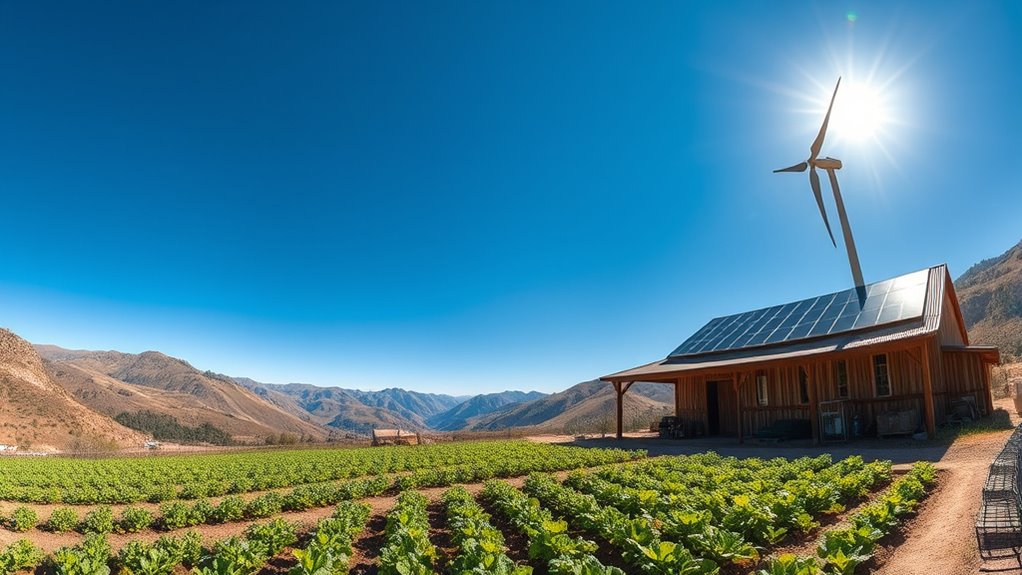
When considering off-grid energy solutions, you'll need to weigh the initial setup costs, which can range from $15,000 to $30,000.
However, the long-term savings potential, especially with solar systems, can substantially offset these expenses over time.
Plus, don't forget about government incentives that can further ease the financial burden of going off-grid.
Initial Setup Costs
Off-grid energy solutions can come with initial setup costs ranging from $15,000 to $30,000, particularly for solar energy systems.
Wind power systems can be a more affordable option, depending on turbine specifications and site conditions. However, keep in mind that you may face additional expenses for maintenance and repairs, especially for battery storage systems that guarantee energy availability.
Consider these factors when budgeting for your off-grid setup:
- Size and components of solar systems
- Specifications for wind power systems
- Maintenance costs for battery storage
- Available government incentives like tax credits
Long-Term Savings Potential
Investing in off-grid energy solutions can yield substantial long-term savings, especially for farms looking to cut down on operational costs. Off-grid solar systems can reduce electricity bills by up to 80%, dramatically lowering your expenses over time.
While initial investments range from $15,000 to $30,000, the long-term savings can be significant, especially when compared to extending grid power lines, which can be up to 60% more expensive.
Incorporating high-quality energy storage, like lithium iron phosphate batteries, maximizes savings with lifespans of at least 10 years.
Successful case studies, such as a poultry farmer recouping solar panel costs within five years, further highlight the rapid return on investment you can expect with off-grid solutions.
Government Incentives Available
Many farmers may not realize the range of government incentives available to ease the shift to off-grid energy solutions.
These incentives can greatly reduce the financial burden of adopting renewable energy systems. Here are some key options to take into account:
- The USDA's Rural Energy for America Program (REAP) can cover up to 25% of renewable energy project costs.
- Federal tax credits offer up to 26% off the installation costs for solar energy systems.
- State-level programs may provide additional grants and low-interest loans tailored to your needs.
- Proper documentation of project costs and adherence to deadlines are essential for securing these government incentives.
Additionally, investing in renewable energy systems like heat pumps can lead to long-term operational savings that further enhance financial viability.
Government Incentives for Renewable Energy Adoption
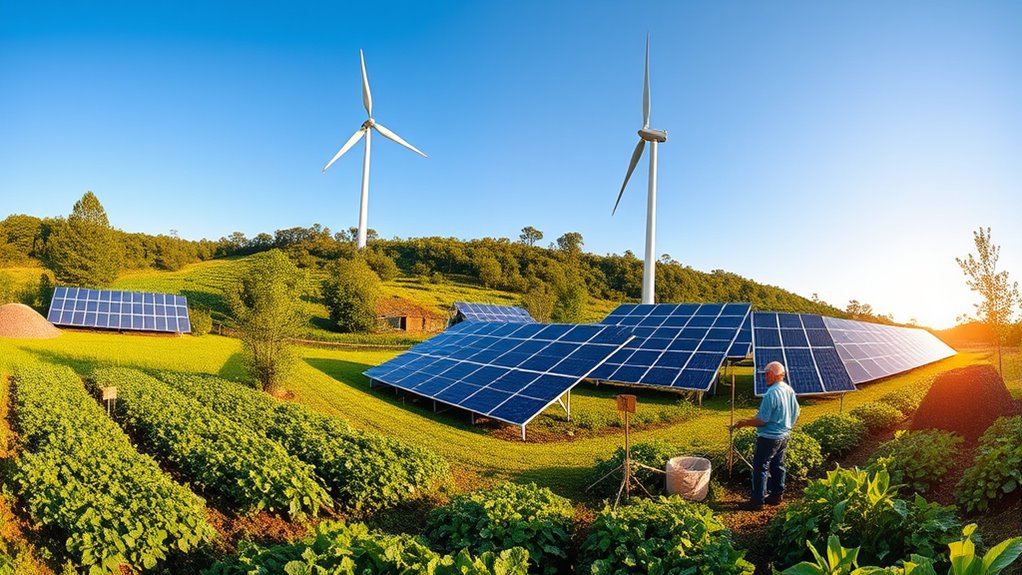
As you explore the potential of renewable energy on your farm, you'll find that government incentives can greatly lighten the financial load. Programs like the USDA's Rural Energy for America Program (REAP) can cover up to 25% of your project costs. Additionally, federal tax credits, such as the Investment Tax Credit (ITC), make solar installations more affordable. Many states provide tailored incentives that enhance the financial viability of your renewable energy projects, ensuring you maximize your investment.
Here's a quick overview of key incentives:
| Incentive Type | Benefits |
|---|---|
| REAP Grants | Up to 25% project cost coverage |
| Investment Tax Credit | Significant installation cost deduction |
| State-Specific Incentives | Tailored support for farms |
| Low-Interest Loans | Affordable financing options |
| Matching Funds | Required for certain grants |
Frequently Asked Questions
What Is the Best Source of Electricity for off the Grid?
When you're looking for the best source of electricity off the grid, consider solar energy first. It harnesses sunlight, making it versatile for various locations.
If you live in a windy area, wind power might be your top choice, as it efficiently converts wind into electricity.
Alternatively, if you have a consistent water source, micro-hydro systems can provide reliable power.
Each option can be tailored to meet your specific energy needs and local conditions.
What Is the Cheapest Way to Get Electricity off the Grid?
Imagine harnessing the sun's rays to power your world—solar energy's often the cheapest way to get electricity off the grid.
Initial costs can seem steep, but government incentives can lighten that load.
Wind power's another wallet-friendly option, especially if you're in a breezy area.
Pairing both solar and wind can boost energy generation while keeping costs down.
Don't forget to implement energy-efficient practices; they'll help you save even more!
What Are the Best Power Options for Off-Grid Living?
When you're considering the best power options for off-grid living, solar power stands out due to its accessibility and efficiency.
Wind turbines can also be a great choice if you're in a windy area.
If you have a reliable water source, micro-hydro systems can generate consistent energy.
Additionally, biogas systems turn organic waste into power.
Don't forget to invest in quality energy storage solutions to guarantee you have power when you need it most.
How Do I Get Electricity to My Off-Grid Property?
"Where there's a will, there's a way."
To get electricity to your off-grid property, start by evaluating your energy needs and calculating the total wattage of your appliances.
Solar power's a great primary option, while wind energy can supplement it if conditions allow.
Don't forget about battery storage for reliability, and if you have a flowing water source, consider a micro-hydro system.
This way, you'll guarantee a consistent power supply for your needs.
Conclusion
Incorporating off-grid energy solutions can transform your remote farming experience. Did you know that solar energy alone can reduce your electricity costs by up to 75%? By harnessing solar, wind, or biogas, you're not just enhancing sustainability but also boosting your farm's resilience. Evaluating your energy needs is essential, and with various financial incentives available, you can make this change more affordable. Embrace these technologies and watch your farm thrive in harmony with nature!



